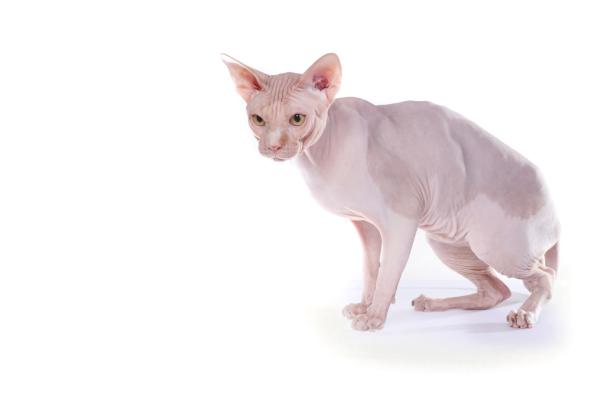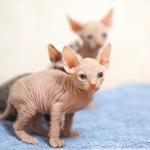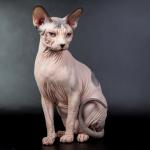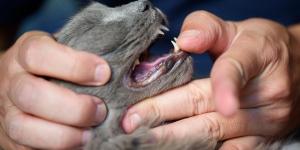Kohana Cat

The Kohana cat is a feline from Hawaii. It is not a differentiated breed in itself, but a mutation of the Sphynx cat breed. It is also a totally hairless cat breed as it lacks hair follicles. Temperamentally, it is an ideal cat for the home. They have a docile, endearing, affectionate and playful character and get along well with children and other animals. When caring for Kohana cats, special attention must be paid to protecting their sensitive skin due to the absence of hair. This is in addition to carrying out the same care and attention that any other cat requires.
AnimalWised brings you everything you need to know about the Kohana cat breed. We look at the origin, characteristics, temperament, care and possible health considerations of this hairless cat breed.
- America
- United States
- 7-11
- 11-13
- 13-17
- 17-22
- 22-30
- 8-10
- 10-15
- 15-18
- 18-20
Origin of the kohana cat
The Kohana cat, also called the Hawaiian hairless cat, is a small American feline native to Hawaii that first appeared in 2002. It was thought to be the result of a natural mutation in a wild litter born in Hawaii that caused the total absence of hair. Later estimations consider the breed a cross between a Donskoy cat and a Sphynx cat. Most recently, DNA of a Kohana specimen was analyzed and it was concluded the breed is a natural mutation that occurrs in the Sphynx cat.
The International Feline Federation (FIFé) does not consider the Kohana cat as an official breed, but rather as a variety of the Sphynx cat. Today it is an enormously rare breed due to the fact that there are very few specimens. Those that exist usually present health problems due to inbreeding.
Characteristics of the Kohana cat
The Kohana cat is a medium-sized, broad, muscular feline which can weigh between 3 and 6 kg (6.6-13 lb) and measure from 17 to 23 cm (6.6-9"). The hind legs of these cats are longer than the front. This gives them a peculiar movement when walking. The musculature of these cats is very well defined, which is even more easily observed due to their lack hair. They have a broad chest and a long, curved tail.
The head is conical in shape, with large, curved ears and large, almond-shaped eyes. The nose is straight and the chin and cheekbones are well defined.
Kohana cat coat colors
The Kohana cat is a feline that lacks hair and hair follicles. Their skin is rubbery to the touch, so the color of these cats will be that of their skin, which is generally white, black or cream.
It should be noted that these muscular cats have wrinkles all over their body, especially on the head, in the area of the forehead and cheeks.
Kohana cat character
The Kohana cat is a very affectionate, sociable, intelligent, energetic and playful feline. They love spending time with their caregivers and really enjoy being the center of attention. In addition, they always seek the company of the caregiver with whom they have developed the strongest bond. In this sense, they are cats that tend to have a favorite person.
Being sociable, they tolerate home visitors better than other breeds, as well as the introduction of new animals. This is as long as introductions are carried out correctly. They are always ready to play, they do not hesitate to provoke and request games with people. They don't like to be home alone. To avoid frustration and behavior problems, it's a good idea for this cat to have enough environmental enrichment resources in the home.
Kohana cat care
These cats lack hair, so they do not have problems with the formation of hairballs and do not require frequent brushing. However, the absence of hair greatly harms their skin, which is fully exposed to the sun, cold, allergies and pathogens. To prevent them from burning, sunscreen should be applied. In the colder months, the home should be kept at a good temperature. Coats and blankets can help to protect them from the cold. A lot of fat and detritus can accumulate on their skin, so you can wipe them with cleaning wipes for cats. It is essential to dry them after to avoid catching a cold.
Continuing with the care of the Kohana cat, the hygiene of the ears, eyes and teeth must be like that of any other cat to prevent infections and inflammations. These cats also lack eyelashes, so eye hygiene cannot be forgotten to prevent feline eye health problems such as conjunctivitis. Read our article on why a cat's eyes are red for more information.
Being so energetic and hairless, their energy needs are greater than most cats. This means Kohana cats need more food per day than the average feline. The food must be complete and intended for the feline species, as well as given in several portions. Water must always be at their disposal
Finally, these cats require committed guardians with enough time and desire to play with them. Since they are very demanding animals, they will need company for most of the day. Likewise, they should have at least one litter box with suitable litter. It should be non-scented to avoid irritation. A scratching post is also important for them to develop scratching behavior and condition their claws. As an adventurous kitty, they should be allowed to climb high, as well as be given suitable toys, games and other forms of environmental enrichment for cats to ensure their well-being and avoid behavioral problems.
Kohana cat health
These cats can live up to 17 years without problem, as long as they are not specimens that have suffered health problems derived from inbreeding due to the limited availability of specimens around the world. If this is not the case, these cats can be in good health. You do have to be particularly mindful of dermatological problems. Their characteristic hairless skin can be prone to developing skin diseases such as melanoma. It is important to prevent them by protecting their skin on a daily basis and carrying out proper hygiene for the rest of your body.
Also required to keep them in good health and provide a high quality of life, it is very important that good preventive medicine is carried out with deworming, vaccinations, sterilization and routine check-ups at the veterinary center. All this will allow us to prevent diseases and quickly diagnose and treat health problems that appear.
Adopting a Kohana cat
Adopting a Kohana cat is extremely difficult and is not recommended due to the prominent inbreeding of the breed and their subsequent health problems. If you have fallen in love with this hairless cat, you should know that there are also other feline breeds or crossbreeds that lack hair. Even if they have fur, any other cat that you can find in your nearest shelter deserves a loving home. Remember, before adopting a cat you should stop to think if you really are a good candidate. You need to ensure you have the time and commitment that a living being needs to have a good quality of life.
If you want to adopt a Kohana cat because you are allergic to cat hair, it is important to note that it is not the coat that causes the allergy. The Sphynx cat and its variants, such as the Kohana, are not considered a hypoallergenic cat breed as they produce the protein Fel d 1 which causes allergies to cats.
Kohana Cat photos












